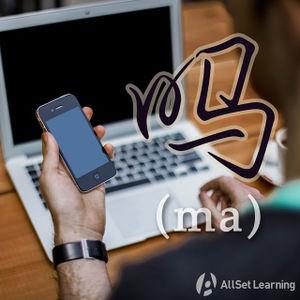Difference between revisions of "Advanced yes-no questions with "ma""
| Line 1: | Line 1: | ||
| − | |||
{{Grammar Box}} | {{Grammar Box}} | ||
| − | The question particle 吗 (ma) is a very simple way to | + | The question particle 吗 (ma) is a very simple way to convert it into a "yes/no question," and beginners will learn ''not to use 吗 with other question words'', because it's redundant. More advanced studentsm however, will note that 吗 has some more complicated structures that do involve combining it with question words in order to ask very specific types of confirming questions. |
== Structure == | == Structure == | ||
| Line 14: | Line 13: | ||
</div> | </div> | ||
| − | If you embed a ''question that uses a question word'' instead of a statement, you can create a more complex kind of 吗 (ma) question: | + | If you embed a ''question that uses a question word'' instead of a statement, you can create a more complex kind of "confirming" 吗 (ma) question: |
<div class="jiegou"> | <div class="jiegou"> | ||
| Line 95: | Line 94: | ||
{{Used for|Asking questions}} | {{Used for|Asking questions}} | ||
{{Used for|Requesting}} | {{Used for|Requesting}} | ||
| − | {{Basic Grammar|吗|B1|...吗?|你 要 什么 <em>吗</em> ?|grammar point| | + | {{Basic Grammar|吗|B1|...吗?|你 要 什么 <em>吗</em> ?|grammar point|ASGI9WXT}} |
{{Similar|Tag questions with ma}} | {{Similar|Tag questions with ma}} | ||
{{Similar|Positive negative questions}} | {{Similar|Positive negative questions}} | ||
| Line 101: | Line 100: | ||
{{Similar|Questions with "le ma"}} | {{Similar|Questions with "le ma"}} | ||
{{Similar|Expressing the self-evident with "ma"}} | {{Similar|Expressing the self-evident with "ma"}} | ||
| − | {{Structure| | + | {{Structure|Particles}} |
Revision as of 03:56, 8 December 2014
-
Level
-
Similar to
-
Used for
-
Keywords
The question particle 吗 (ma) is a very simple way to convert it into a "yes/no question," and beginners will learn not to use 吗 with other question words, because it's redundant. More advanced studentsm however, will note that 吗 has some more complicated structures that do involve combining it with question words in order to ask very specific types of confirming questions.
Structure
You'll remember that this is the simple pattern for yes/no questions:
Statement + 吗 ?
If you embed a question that uses a question word instead of a statement, you can create a more complex kind of "confirming" 吗 (ma) question:
[Question-word Question] + 吗 ?
Examples of common question words include 什么 (shénme), 谁 (shéi), and 哪里 (nǎli).
Examples
Note that the following examples typically contains some kind of "verb of understanding" such as 知道 (zhīdao),了解 (liǎojié), 明白 (míngbai), 认识 (rènshi), etc. Then "吗" (ma) can still be added at the end of the question, turning it into a kind of confirmation. For example:
- 这 是 什么 东西 ?What is this thing?
- 你 知道 这 是 什么 东西 吗?Do you know what this thing is?
- 他 是 谁 ?Who is he?
- 你 知道 他 是 谁 吗?Do you know who he is?
- 这 是 什么 意思 ?What is the meaning of this?
- 你 明白 这 是 什么 意思 吗?Do you understand the meaning of this?
- 他 的 问题 是 什么 ?What is his question?
- 你 明白 他 的 问题 是 什么 吗?Do you understand what his question is?
- 怎么 学 中文 ?How does one learn Chinese?
- 你 知道 怎么 学 中文 吗?Do you know how to learn Chinese?
- 他 叫 什么 名字 ?What is ihis name?
- 你 知道 他 叫 什么 名字 吗?Do you what his name is?
- 王 老师 在 哪里 ?Where is Teacher Wang?
- 你 知道 王 老师 在 哪里 吗?Do you know where Teacher Wang is?
See also
Sources and further reading
Books
- Chinese: An Essential Grammar, Second Edition (pp. 138-40) →buy
- Integrated Chinese: Level 1, Part 1 (3rd ed) (pp. 29-30) →buy
- New Practical Chinese Reader 1 (新实用汉语课本1) (p. 21) →buy
- New Practical Chinese Reader 1 (新实用汉语课本1)(2nd ed) (pp. 23, 250) →buy



